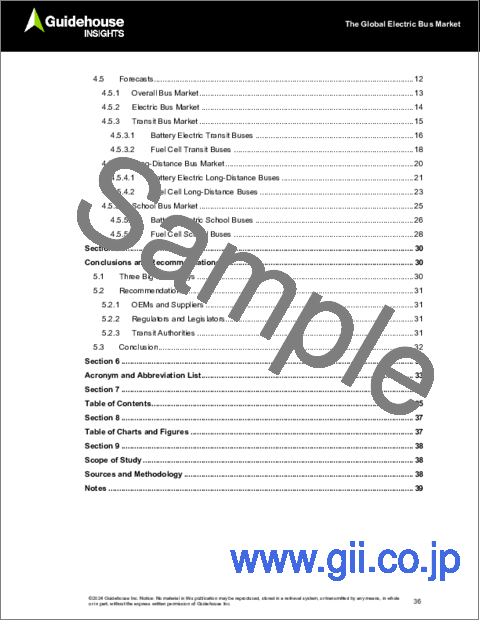|
|
市場調査レポート
商品コード
1486361
電気バスの世界市場:バッテリー電気式および燃料電池式の大型乗用車の市場予測 (2025~2034年)The Global Electric Bus Market: Battery Electric and Fuel Cell Heavy Passenger Vehicles, Market Forecasts, 2025-2034 |
||||||
|
|||||||
| 電気バスの世界市場:バッテリー電気式および燃料電池式の大型乗用車の市場予測 (2025~2034年) |
|
出版日: 2024年05月28日
発行: Guidehouse Research
ページ情報: 英文 40 Pages; 45 Tables, Charts & Figures
納期: 即納可能
|
全表示
- 概要
- 図表
- 目次
バスは経済発展と社会移動の両方を可能にし、国際社会で根本的な役割を果たしています。大量旅客輸送は、世界のあらゆる地域で基本的に必要なものであり、バスは歴史的に必要な輸送能力の多くを提供してきたし、今後もそうなると考えられています。バスはまた、電化によって、単純ながら非常に効果的な脱炭素化手段を提供します。
世界のバス市場は成熟していますが、電気バス市場はそうで無いかもしれません。旅客輸送は脱炭素化の明確なチャンスと見なされており、内燃機関以外の代替推進方法への関心は過去10年間で高まりつつあります。当レポートでは、今後10年間の世界の大型電気バス市場について分析しています。バス市場全体を路線バス・長距離バス・スクールバスの3つのカテゴリーに分類して予測すると共に、3つのセグメントの各々について、バッテリー電気式 (BE) と燃料電池式 (FC) の両方の販売台数と普及率を示しています。
BEバスの採用は、特に路線バスとスクールバスのセグメントですでに進行中であり、勢いを増している一方、FCバスの見通しは、コストと適切性の両方の要因を受けて、はるかに不確実であると考えられています。
当レポートでは、世界の電気バスの市場について分析し、市場の基本構造やバリューチェーン、主な促進・抑制要因、全体的な市場規模の動向見通し、セグメント別・車種別の詳細動向などを調査しております。
目次
第1章 エグゼクティブサマリー
第2章 市場の問題
- 促進要因
- インセンティブ
- 地域の排出規制
- 現地の規制
- 入札・調達基準
- 調達コスト
- 抑制要因
- 寒冷気候の影響
- 信頼性と互換性の欠如
- 訓練を受けた技術者の不足
- 充電の問題
- 価格
第3章 産業バリューチェーン
- 競合情勢
- 企業合併・買収 (M&A)
- ビジネスモデルの進化
第4章 市場予測
- 範囲
- 調査手法
- 制限事項
- 主な前提
- 予測
- バス市場全体
- 電気バス市場
- 路線バス市場
- 長距離バス市場
- スクールバス市場
第5章 結論・提言
- 3つの大きなポイント
- 推奨事項
- OEM・サプライヤー
- 規制当局と立法者
- 交通当局
- 結論
第6章 頭字語と略語一覧
第7章 目次
第8章 図表
第9章 調査範囲、情報源・調査手法、注釈
List of Tables
- Bus Sales by Region, World Markets: 2025-2034
- Bus Market Share by Region, World Markets: 2025-2034
- Transit Bus Sales by Region, World Markets: 2025-2034
- Long-Distance Bus Sales by Region, World Markets: 2025-2034
- School Bus Sales by Region, World Markets: 2025-2034
- Electric Bus Sales by Region, World Markets: 2025-2034
- Electric Bus Adoption Rate by Region, World Markets: 2025-2034
- ICE Bus Sales by Region, World Markets: 2025-2034
- ICE Bus Adoption Rate by Region, World Markets: 2025-2034
- Bus Market Share by Powertrain, World Markets: 2025-2034
- BE Bus Sales by Region, World Markets: 2025-2034
- BE Transit Bus Sales by Region, World Markets: 2025-2034
- BE Transit Bus Adoption Rate by Region, World Markets: 2025-2034
- BE Long-Distance Bus Sales by Region, World Markets: 2025-2034
- BE Long-Distance Bus Adoption Rate by Region, World Markets: 2025-2034
- BE School Bus Sales by Region, World Markets: 2025-2034
- BE School Bus Adoption Rate by Region, World Markets: 2025-2034
- FC Bus Sales by Region, World Markets: 2025-2034
- FC Transit Bus Sales by Region, World Markets: 2025-2034
- FC Transit Bus Adoption Rate by Region, World Markets: 2025-2034
- FC Long-Distance Bus Sales by Region, World Markets: 2025-2034
- FC Long-Distance Bus Adoption Rate by Region, World Markets: 2025-2034
- FC School Bus Sales by Region, World Markets: 2025-2034
- FC School Bus Adoption Rate by Region, World Markets: 2025-2034
List of Figures
- Bus Market Share by Powertrain, World Markets: 2025-2034
- Bus Sales by Region, World Markets: 2025-2034
- Mean Distance between Transit Bus Road Calls, Twin Cities, MN: 2019-2022
- Electric Bus Sales by Region, World Markets: 2025-2034
- Transit Bus Sales by Region, World Markets: 2025-2034
- BE Transit Bus Sales by Region, World Markets: 2025-2034
- BE Transit Bus Adoption Rate by Region, World Markets: 2025-2034
- FC Transit Bus Sales by Region, World Markets: 2025-2034
- FC Transit Bus Adoption Rate by Region, World Markets: 2025-2034
- Long-Distance Bus Sales by Region, World Markets: 2025-2034
- BE Long-Distance Bus Sales by Region, World Markets: 2025-2034
- BE Long-Distance Bus Adoption Rate by Region, World Markets: 2025-2034
- FC Long-Distance Bus Sales by Region, World Markets: 2025-2034
- FC Long-Distance Bus Adoption Rate by Region, World Markets: 2025-2034
- School Bus Sales by Region, World Markets: 2025-2034
- BE School Bus Sales by Region, World Markets: 2025-2034
- BE School Bus Adoption Rate by Region, World Markets: 2025-2034
- FC School Bus Sales by Region, World Markets: 2025-2034
- FC School Bus Adoption Rate by Region, World Markets: 2025-2034
Electric Bus Value Chain
Forecast Regions
Buses play a fundamental role in global society, enabling both economic development and social mobility. Mass passenger transport is a fundamental necessity in every part of the world, and buses have historically provided much of the necessary capacity and will likely continue to do so. They also offer a simple yet highly effective decarbonization lever via electrification.
The global bus market is a mature one, but the same may not be said for the electric bus market. Passenger transport is regarded as a clear opportunity for decarbonization, and interest in non-internal combustion engine alternative propulsion methods has been developing over the last decade. This Guidehouse Insights report examines the global market for heavy electric buses over the next 10 years. It presents forecasts for the overall bus market segmented into three categories: transit buses, long-distance buses, and school buses. For these three segments, unit sales and adoption rates are presented for both battery electric (BE) and fuel cell (FC) vehicles.
The report concludes that, while the adoption of BE buses-most notably in the transit and school bus segments-is already well underway and developing momentum, the outlook for FC buses is far less assured, as a function of both cost and appropriateness.
Table of Contents
1. Executive Summary
2. Market Issues
- 2.1 Drivers
- 2.1.1 Incentivization
- 2.1.2 Regional Emissions Regulations
- 2.1.2.1 North America
- 2.1.2.2 Europe
- 2.1.2.3 Asia Pacific
- 2.1.3 Local Regulations
- 2.1.4 Tendering and Procurement Criteria
- 2.1.5 Procurement Cost
- 2.2 Barriers
- 2.1 Cold Weather Impact
- 2.2.2 Lack of Reliability and Interchangeability
- 2.2.3 Lack of Trained Technicians
- 2.2.4 Charging Issues
- 2.3 Pricing
3. Industry Value Chain
- 3.1 Competitive Landscape
- 3.1.1 Mergers and Acquisitions
- 3.1.2 Business Model Evolution
4. Market Forecasts
- 4.1 Scope
- 4.2 Methodology
- 4.3 Limitations
- 4.4 Key Assumptions
- 4.5 Forecasts
- 4.5.1 Overall Bus Market
- 4.5.2 Electric Bus Market
- 4.5.3 Transit Bus Market
- 4.5.3.1 Battery Electric Transit Buses
- 4.5.3.2 Fuel Cell Transit Buses
- 4.5.4 Long-Distance Bus Market
- 4.5.4.1 Battery Electric Long-Distance Buses
- 4.5.4.2 Fuel Cell Long-Distance Buses
- 4.5.5 School Bus Market
- 4.5.5.1 Battery Electric School Buses
- 4.5.5.2 Fuel Cell School Buses
5. Conclusions and Recommendations
- 5.1 Three Big Takeaways
- 5.2 Recommendations
- 5.2.1 OEMs and Suppliers
- 5.2.2 Regulators and Legislators
- 5.2.3 Transit Authorities
- 5.3 Conclusion






